Alfa Romeo MiTo 2015 Owner's Manual
Manufacturer: ALFA ROMEO, Model Year: 2015, Model line: MiTo, Model: Alfa Romeo MiTo 2015Pages: 280, PDF Size: 8.52 MB
Page 121 of 280
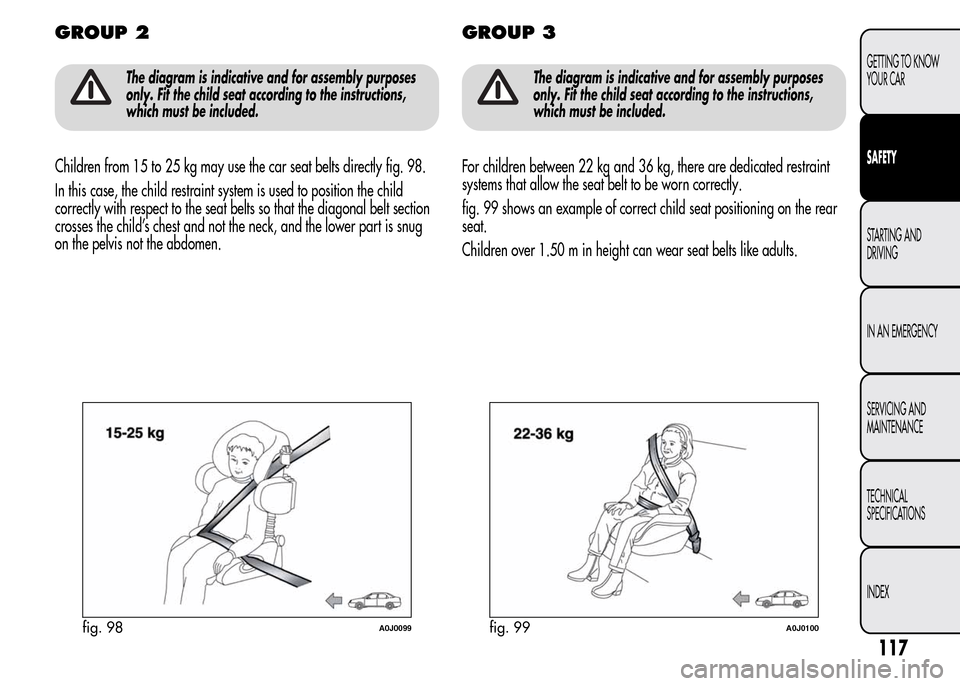
GROUP 2
The diagram is indicative and for assembly purposes
only. Fit the child seat according to the instructions,
which must be included.
Children from 15 to 25 kg may use the car seat belts directly fig. 98.
In this case, the child restraint system is used to position the child
correctly with respect to the seat belts so that the diagonal belt section
crosses the child’s chest and not the neck, and the lower part is snug
on the pelvis not the abdomen.
GROUP 3
The diagram is indicative and for assembly purposes
only. Fit the child seat according to the instructions,
which must be included.
For children between 22 kg and 36 kg, there are dedicated restraint
systems that allow the seat belt to be worn correctly.
fig. 99 shows an example of correct child seat positioning on the rear
seat.
Children over 1.50 m in height can wear seat belts like adults.
fig. 98A0J0099fig. 99A0J0100
117
GETTING TO KNOW
YOUR CAR
SAFETY
STARTING AND
DRIVING
IN AN EMERGENCY
SERVICING AND
MAINTENANCE
TECHNICAL
SPECIFICATIONS
INDEX
Page 122 of 280
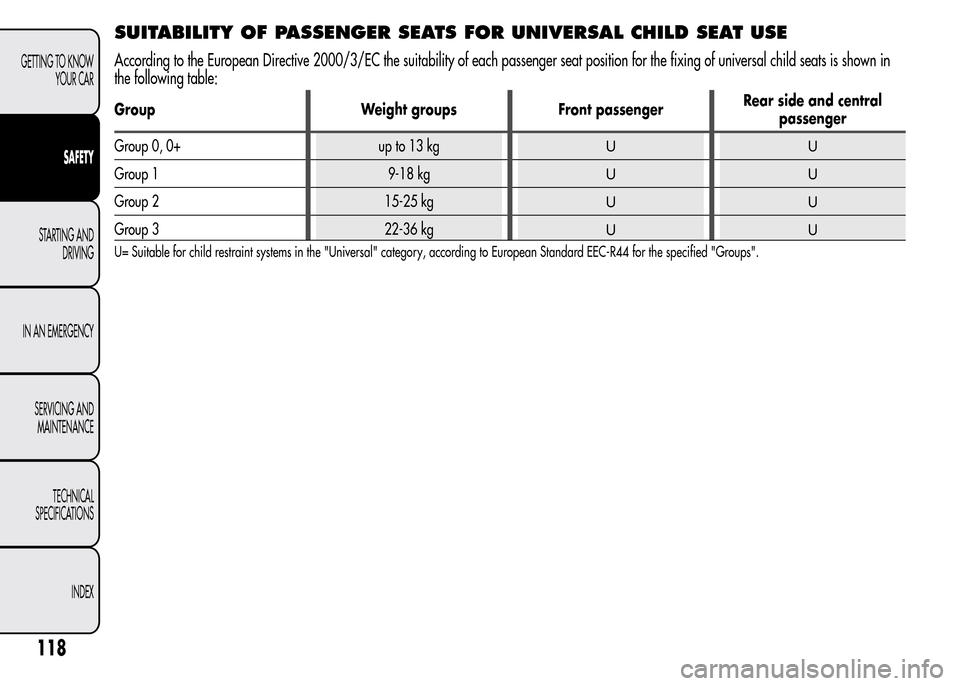
SUITABILITY OF PASSENGER SEATS FOR UNIVERSAL CHILD SEAT USE
According to the European Directive 2000/3/EC the suitability of each passenger seat position for the fixing of universal child seats is shown in
the following table:
Group Weight groups Front passengerRear side and central
passenger
Group 0, 0+ up to 13 kg
UU
Group 1 9-18 kgUU
Group 2 15-25 kgUU
Group 3 22-36 kgUU
U= Suitable for child restraint systems in the "Universal" category, according to European Standard EEC-R44 for the specified "Groups".
118
GETTING TO KNOW
YOUR CAR
SAFETY
STARTING AND
DRIVING
IN AN EMERGENCY
SERVICING AND
MAINTENANCE
TECHNICAL
SPECIFICATIONS
INDEX
Page 123 of 280
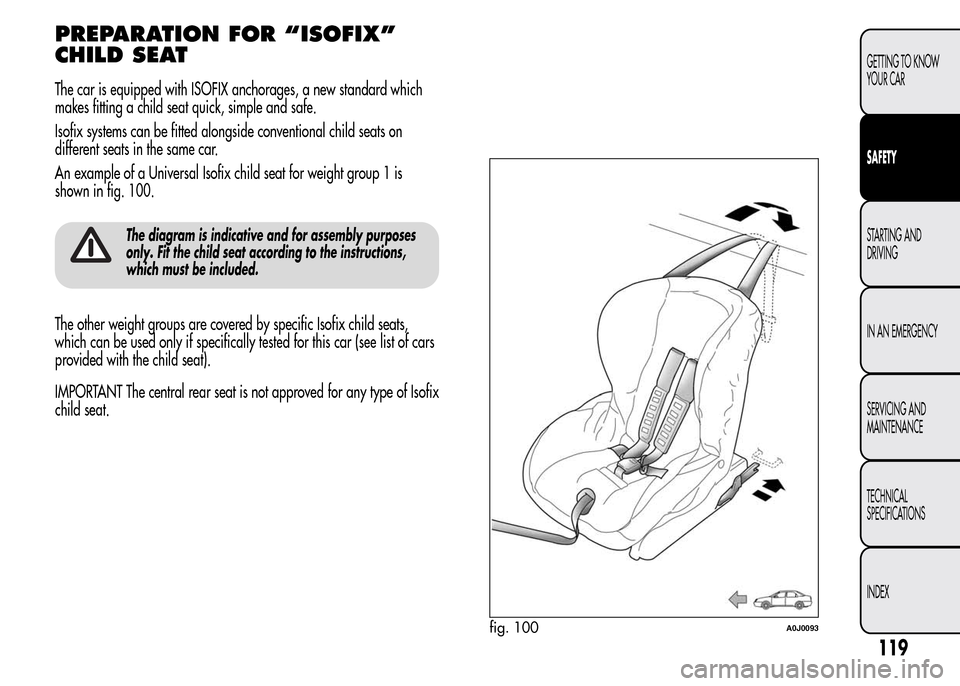
PREPARATION FOR “ISOFIX”
CHILD SEAT
The car is equipped with ISOFIX anchorages, a new standard which
makes fitting a child seat quick, simple and safe.
Isofix systems can be fitted alongside conventional child seats on
different seats in the same car.
An example of a Universal Isofix child seat for weight group 1 is
shown in fig. 100.
The diagram is indicative and for assembly purposes
only. Fit the child seat according to the instructions,
which must be included.
The other weight groups are covered by specific Isofix child seats,
which can be used only if specifically tested for this car (see list of cars
provided with the child seat).
IMPORTANT The central rear seat is not approved for any type of Isofix
child seat.
fig. 100A0J0093
119
GETTING TO KNOW
YOUR CAR
SAFETY
STARTING AND
DRIVING
IN AN EMERGENCY
SERVICING AND
MAINTENANCE
TECHNICAL
SPECIFICATIONS
INDEX
Page 124 of 280
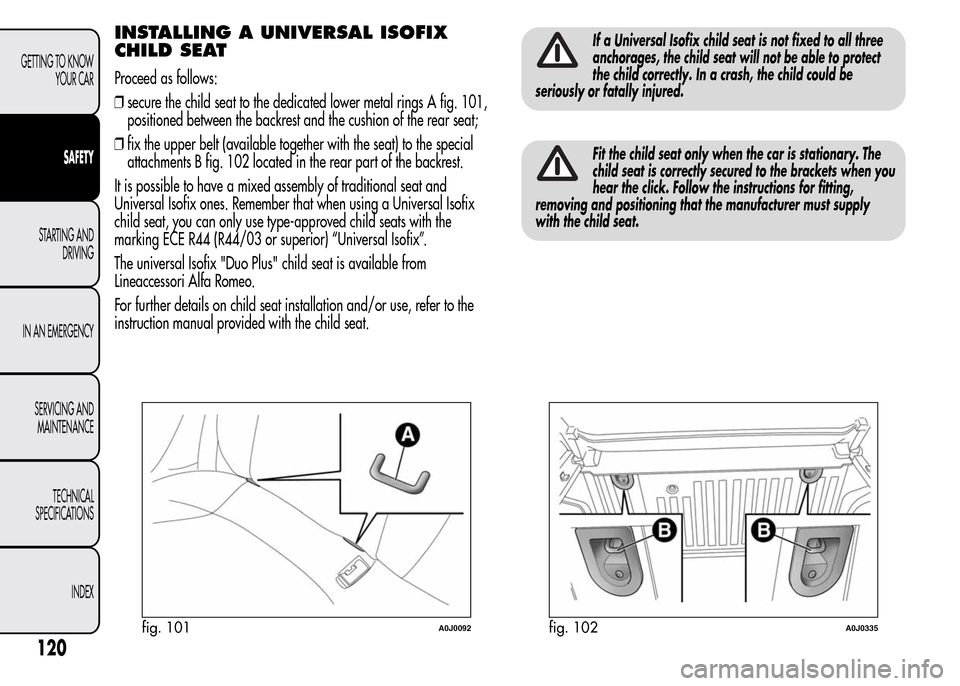
INSTALLING A UNIVERSAL ISOFIX
CHILD SEAT
Proceed as follows:
❒secure the child seat to the dedicated lower metal rings A fig. 101,
positioned between the backrest and the cushion of the rear seat;
❒fix the upper belt (available together with the seat) to the special
attachments B fig. 102 located in the rear part of the backrest.
It is possible to have a mixed assembly of traditional seat and
Universal Isofix ones. Remember that when using a Universal Isofix
child seat, you can only use type-approved child seats with the
marking ECE R44 (R44/03 or superior) “Universal Isofix”.
The universal Isofix "Duo Plus" child seat is available from
Lineaccessori Alfa Romeo.
For further details on child seat installation and/or use, refer to the
instruction manual provided with the child seat.
If a Universal Isofix child seat is not fixed to all three
anchorages, the child seat will not be able to protect
the child correctly. In a crash, the child could be
seriously or fatally injured.
Fit the child seat only when the car is stationary. The
child seat is correctly secured to the brackets when you
hear the click. Follow the instructions for fitting,
removing and positioning that the manufacturer must supply
with the child seat.
fig. 101A0J0092fig. 102A0J0335
120
GETTING TO KNOW
YOUR CAR
SAFETY
STARTING AND
DRIVING
IN AN EMERGENCY
SERVICING AND
MAINTENANCE
TECHNICAL
SPECIFICATIONS
INDEX
Page 125 of 280
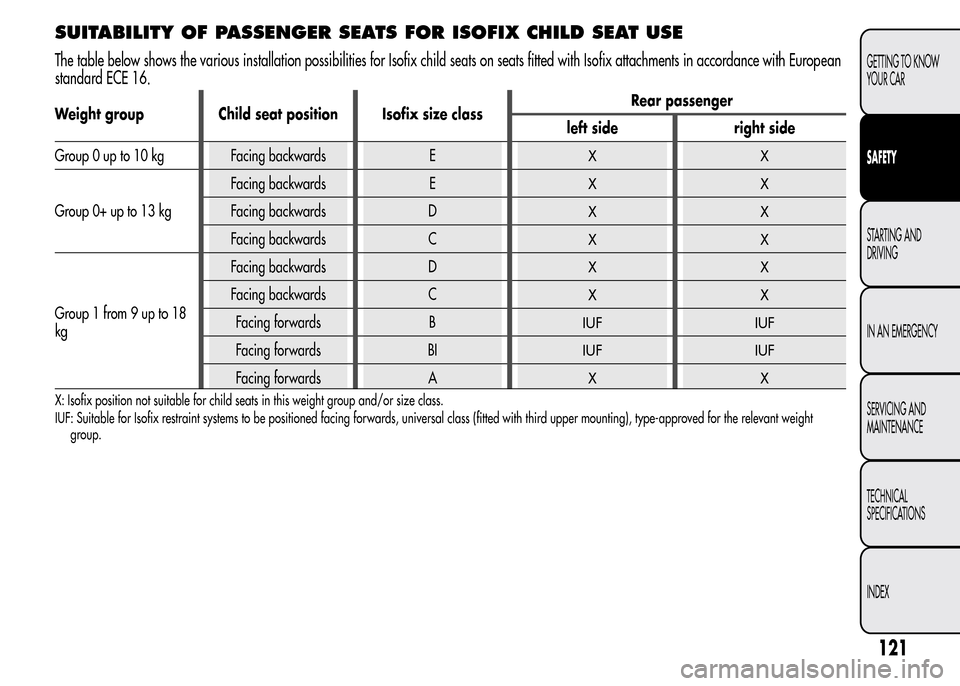
SUITABILITY OF PASSENGER SEATS FOR ISOFIX CHILD SEAT USE
The table below shows the various installation possibilities for Isofix child seats on seats fitted with Isofix attachments in accordance with European
standard ECE 16.
Weight group Child seat position Isofix size classRear passenger
left side right side
Group 0 up to 10 kg Facing backwards E
XX
Group 0+ up to 13 kgFacing backwards E
XX
Facing backwards DXX
Facing backwards CXX
Group 1 from 9 up to 18
kgFacing backwards D
XX
Facing backwards CXX
Facing forwards BIUF IUF
Facing forwards BIIUF IUF
Facing forwards AXX
X: Isofix position not suitable for child seats in this weight group and/or size class.
IUF: Suitable for Isofix restraint systems to be positioned facing forwards, universal class (fitted with third upper mounting), type-approved forthe relevant weight
group.
121
GETTING TO KNOW
YOUR CAR
SAFETY
STARTING AND
DRIVING
IN AN EMERGENCY
SERVICING AND
MAINTENANCE
TECHNICAL
SPECIFICATIONS
INDEX
Page 126 of 280
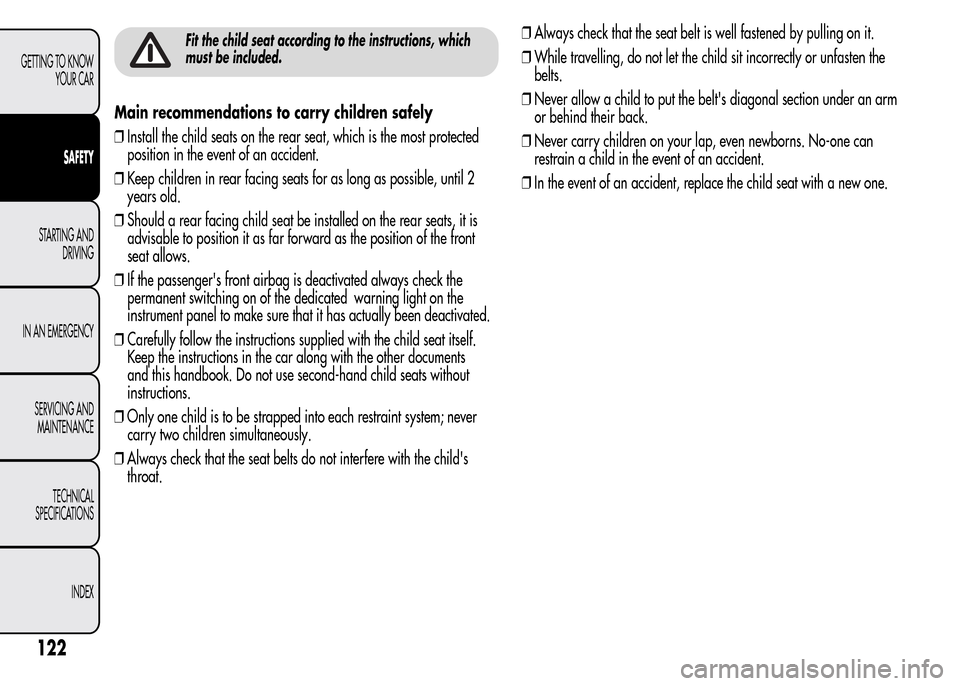
Fit the child seat according to the instructions, which
must be included.
Main recommendations to carry children safely
❒Install the child seats on the rear seat, which is the most protected
position in the event of an accident.
❒Keep children in rear facing seats for as long as possible, until 2
years old.
❒Should a rear facing child seat be installed on the rear seats, it is
advisable to position it as far forward as the position of the front
seat allows.
❒If the passenger's front airbag is deactivated always check the
permanent switching on of the dedicated warning light on the
instrument panel to make sure that it has actually been deactivated.
❒Carefully follow the instructions supplied with the child seat itself.
Keep the instructions in the car along with the other documents
and this handbook. Do not use second-hand child seats without
instructions.
❒Only one child is to be strapped into each restraint system; never
carry two children simultaneously.
❒Always check that the seat belts do not interfere with the child's
throat.❒Always check that the seat belt is well fastened by pulling on it.
❒While travelling, do not let the child sit incorrectly or unfasten the
belts.
❒Never allow a child to put the belt's diagonal section under an arm
or behind their back.
❒Never carry children on your lap, even newborns. No-one can
restrain a child in the event of an accident.
❒In the event of an accident, replace the child seat with a new one.
122
GETTING TO KNOW
YOUR CAR
SAFETY
STARTING AND
DRIVING
IN AN EMERGENCY
SERVICING AND
MAINTENANCE
TECHNICAL
SPECIFICATIONS
INDEX
Page 127 of 280
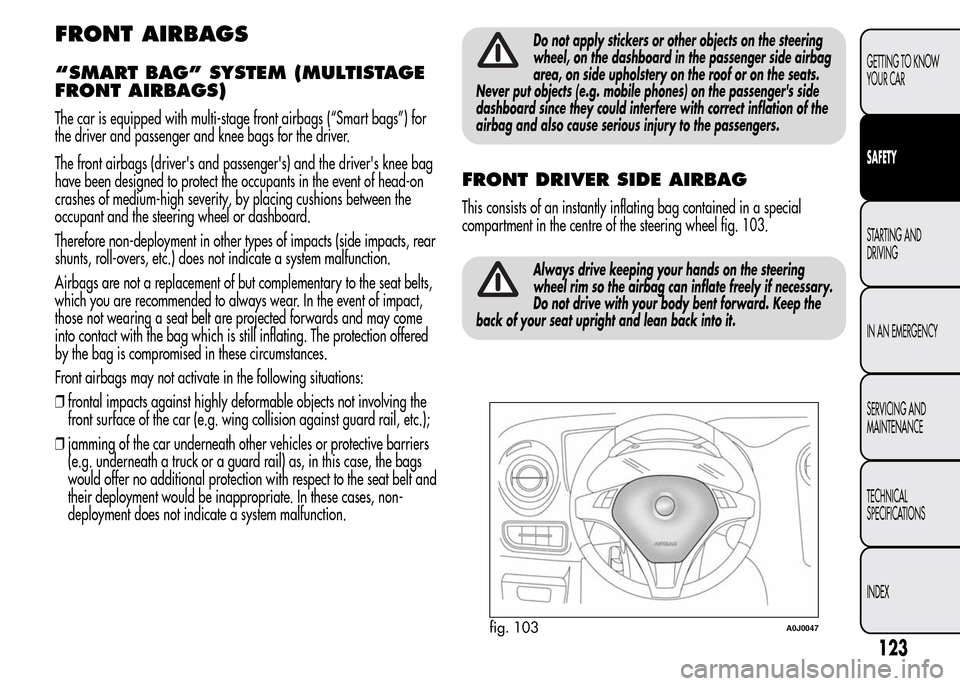
FRONT AIRBAGS
“SMART BAG” SYSTEM (MULTISTAGE
FRONT AIRBAGS)
The car is equipped with multi-stage front airbags (“Smart bags”) for
the driver and passenger and knee bags for the driver.
The front airbags (driver's and passenger's) and the driver's knee bag
have been designed to protect the occupants in the event of head-on
crashes of medium-high severity, by placing cushions between the
occupant and the steering wheel or dashboard.
Therefore non-deployment in other types of impacts (side impacts, rear
shunts, roll-overs, etc.) does not indicate a system malfunction.
Airbags are not a replacement of but complementary to the seat belts,
which you are recommended to always wear. In the event of impact,
those not wearing a seat belt are projected forwards and may come
into contact with the bag which is still inflating. The protection offered
by the bag is compromised in these circumstances.
Front airbags may not activate in the following situations:
❒frontal impacts against highly deformable objects not involving the
front surface of the car (e.g. wing collision against guard rail, etc.);
❒jamming of the car underneath other vehicles or protective barriers
(e.g. underneath a truck or a guard rail) as, in this case, the bags
would offer no additional protection with respect to the seat belt and
their deployment would be inappropriate. In these cases, non-
deployment does not indicate a system malfunction.
Do not apply stickers or other objects on the steering
wheel, on the dashboard in the passenger side airbag
area, on side upholstery on the roof or on the seats.
Never put objects (e.g. mobile phones) on the passenger's side
dashboard since they could interfere with correct inflation of the
airbag and also cause serious injury to the passengers.
FRONT DRIVER SIDE AIRBAG
This consists of an instantly inflating bag contained in a special
compartment in the centre of the steering wheel fig. 103.
Always drive keeping your hands on the steering
wheel rim so the airbag can inflate freely if necessary.
Do not drive with your body bent forward. Keep the
back of your seat upright and lean back into it.
fig. 103A0J0047
123
GETTING TO KNOW
YOUR CAR
SAFETY
STARTING AND
DRIVING
IN AN EMERGENCY
SERVICING AND
MAINTENANCE
TECHNICAL
SPECIFICATIONS
INDEX
Page 128 of 280
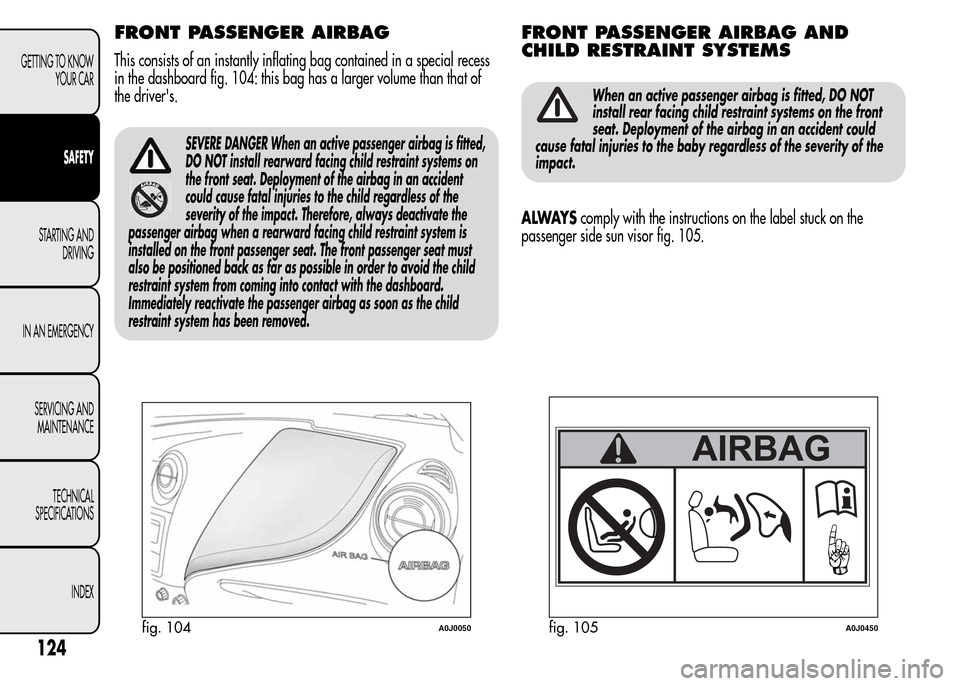
FRONT PASSENGER AIRBAG
This consists of an instantly inflating bag contained in a special recess
in the dashboard fig. 104: this bag has a larger volume than that of
the driver's.
SEVERE DANGER When an active passenger airbag is fitted,
DO NOT install rearward facing child restraint systems on
the front seat. Deployment of the airbag in an accident
could cause fatal injuries to the child regardless of the
severity of the impact. Therefore, always deactivate the
passenger airbag when a rearward facing child restraint system is
installed on the front passenger seat. The front passenger seat must
also be positioned back as far as possible in order to avoid the child
restraint system from coming into contact with the dashboard.
Immediately reactivate the passenger airbag as soon as the child
restraint system has been removed.
FRONT PASSENGER AIRBAG AND
CHILD RESTRAINT SYSTEMS
When an active passenger airbag is fitted, DO NOT
install rear facing child restraint systems on the front
seat. Deployment of the airbag in an accident could
cause fatal injuries to the baby regardless of the severity of the
impact.
ALWAYScomply with the instructions on the label stuck on the
passenger side sun visor fig. 105.
fig. 104A0J0050fig. 105A0J0450
124
GETTING TO KNOW
YOUR CAR
SAFETY
STARTING AND
DRIVING
IN AN EMERGENCY
SERVICING AND
MAINTENANCE
TECHNICAL
SPECIFICATIONS
INDEX
Page 129 of 280
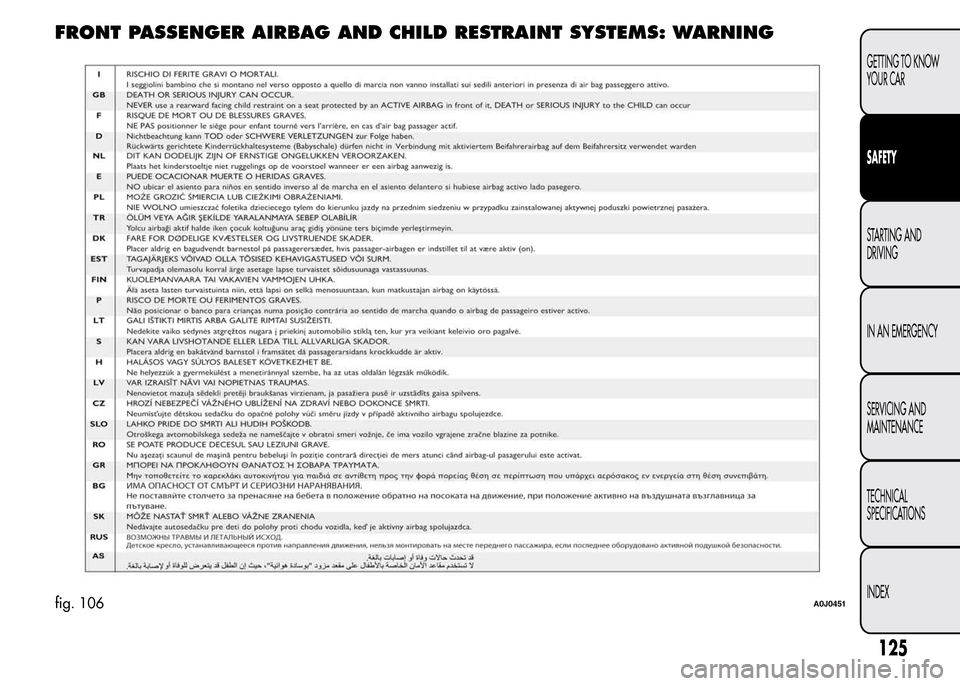
FRONT PASSENGER AIRBAG AND CHILD RESTRAINT SYSTEMS: WARNING
fig. 106A0J0451
125
GETTING TO KNOW
YOUR CAR
SAFETY
STARTING AND
DRIVING
IN AN EMERGENCY
SERVICING AND
MAINTENANCE
TECHNICAL
SPECIFICATIONS
INDEX
Page 130 of 280
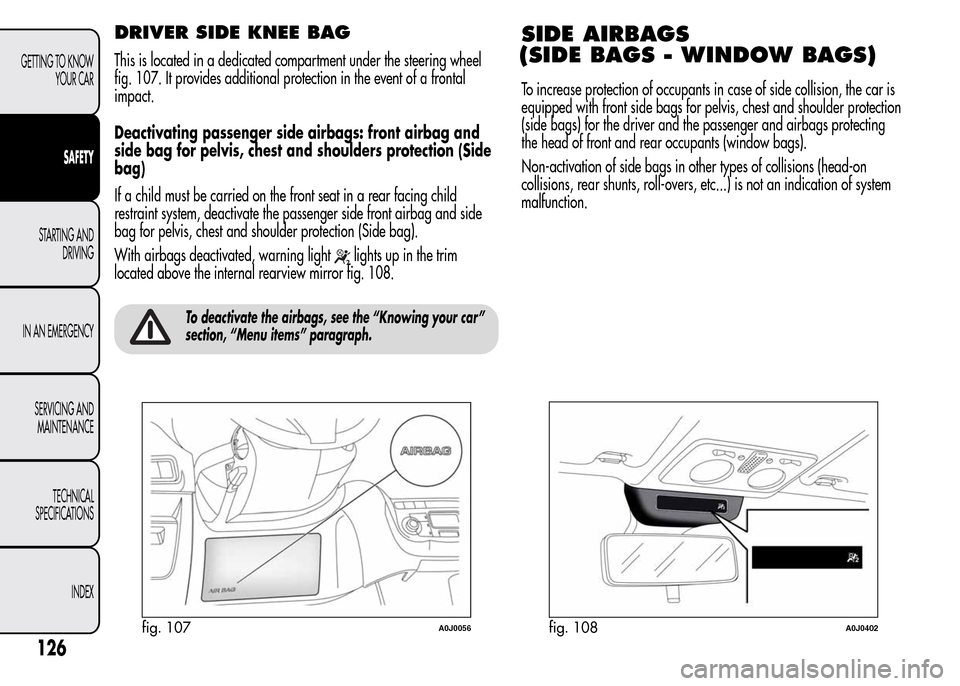
DRIVER SIDE KNEE BAG
This is located in a dedicated compartment under the steering wheel
fig. 107. It provides additional protection in the event of a frontal
impact.
Deactivating passenger side airbags: front airbag and
side bag for pelvis, chest and shoulders protection (Side
bag)
If a child must be carried on the front seat in a rear facing child
restraint system, deactivate the passenger side front airbag and side
bag for pelvis, chest and shoulder protection (Side bag).
With airbags deactivated, warning light
lights up in the trim
located above the internal rearview mirror fig. 108.
To deactivate the airbags, see the “Knowing your car”
section, “Menu items” paragraph.
SIDE AIRBAGS
(SIDE BAGS - WINDOW BAGS)
To increase protection of occupants in case of side collision, the car is
equipped with front side bags for pelvis, chest and shoulder protection
(side bags) for the driver and the passenger and airbags protecting
the head of front and rear occupants (window bags).
Non-activation of side bags in other types of collisions (head-on
collisions, rear shunts, roll-overs, etc...) is not an indication of system
malfunction.
fig. 107A0J0056fig. 108A0J0402
126
GETTING TO KNOW
YOUR CAR
SAFETY
STARTING AND
DRIVING
IN AN EMERGENCY
SERVICING AND
MAINTENANCE
TECHNICAL
SPECIFICATIONS
INDEX